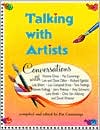
BIBLIOGRAPHY
McKissack, Patricia C. 2006. PORCH LIES: TALES OF SLICKSTERS, TRICKSTERS, AND OTHER WILY CHARACTERS. Ill. by Andre Carrilho. New York: Swartz & Wade Books. ISBN 0375836195
PLOT SUMMARY
In this anthology of literary tales, Patricia McKissack draws on the childhood stories heard on her grandparents’ porch as well as traditional African American folktales to create her own version of “porch lies.” McKissack populates her imaginary front porch with a cast of characters who are more than willing to share their favorite tale of a slickster or trickster.
The result is a colorful collection of ten stories each with their own memorable character including: Pete Bruce who tricks the Pie Lady into feeding him an entire coconut pie one taste at a time; Mingo Cass who pays all his debts without breaking his only one hundred dollar bill; Aunt Gran who tricks and slicks Jesse James into getting rid of the leader of “the worst gang of hate-filled Confederates ever there was”; and Montgomery Red who outsmarts the King of the Ghosts.
CRITICAL ANALYSIS
In the Author’s Note that precedes the ten tales, McKissack recalls that her favorite childhood memories include summer evenings sitting on the front porch of her grandparents’ home and listening to the “porch lies.” According to McKissack, she drew on those tales as well as other elements of the African American oral tradition for this book. She invites the reader to settle in “to the front porch of your mind” and enjoy her versions of African American folktales, myths and legends.
McKissack starts each tale with an introduction of the fictitious narrator that provides a mental picture of the storyteller as well as sets the stage for the tale to follow. McKissack has the ability to make each character seem so real that each tale carries a hint of truth throughout its pages. On occasion, McKissack even challenges the reader to “decide if it is a porch lie or not.”
Even though each tale is set in Tennessee or another southern location, each story has the folktale air of long ago and far away. The effect is heightened by the black and white artwork of illustrator Andre Carrilho. Each character that McKissack presents as real is drawn as an exaggerated caricature which lends an additional quality of fantasy to each story.
Present in each of McKissack’s tales is a trickster/slickster persona such as Pete Bruce who is “nothing but an ol’ confidencer.” Clovis Reed finds, to his surprise, that the good he has done outweighs the bad “by the weight of a single feather.” Bukka Black, after pretending to be a famous blues guitarist, almost succumbs to the devil’s charms when he comes to collect his dues. The underlying theme across all the stories is that there is some good to be found in even the most outrageous trickster. Even Link Murphy who is tagged as a “sneasel” (part snake and part weasel) proves his worth by saving Mis’ Crickett from being buried alive.
Younger readers may have trouble reading this book independently, but it will be a favorite when read aloud at story time or on a summer evening sitting on the front porch sipping lemonade.
REVIEW EXCERPT(S)
BOOKLIST: “Great for sharing, on the porch and in the classroom.”
KIRKUS REVIEWS: “… these tales all lend themselves to telling or reading aloud, and carry the common theme that even the worst rascals have saving graces.”
HORN BOOK: “Grandly melodramatic black-and-white illustrations capture the stories' mood.”
CONNECTIONS
This book would be an excellent supplement to a unit on African American history.
Gather other collections of trickster tales such as:
San Souci, Robert D. SISTER TRICKSTERS : ROLLICKING TALES OF CLEVER FEMALES. ISBN 087483791X
DeSpain, Pleasant. TALES OF TRICKSTERS. ISBN 0874836441
Matthews, John and Caitlin. TRICK OF THE TALE : A COLLECTION OF TRICKSTER TALES. ISBN 0763636460
Read and discuss other books by Patricia McKissack:
McKissack, Patricia. THE DARK-THIRTY : SOUTHERN TALES OF THE SUPERNATURAL. ISBN 0679818634
McKissack, Patricia. MA DEAR'S APRONS. ISBN 0689810512
McKissack, Patricia. GOIN' SOMEPLACE SPECIAL. ISBN 0689818858




